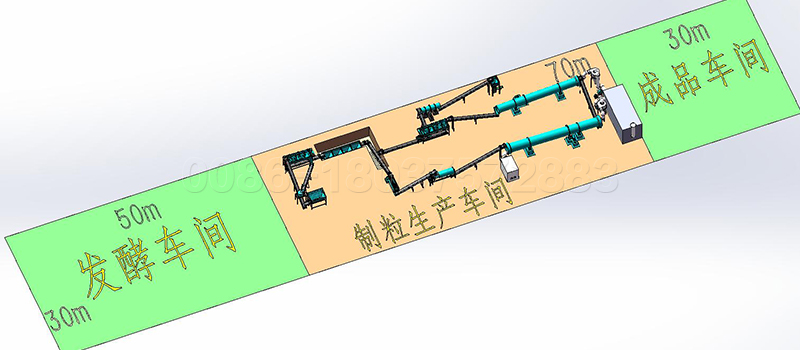I said that we have a professional organic fertilizer production line to help us make organic fertilizer.
The basic process includes fermentation process, complex process and granulation process.The most important part is the granulation process.
Granulation process section
(1) Crusher (fertilizer crusher)
The materials were crushed and fermented for 1 day, then dried, crushed and screened for fermented organic materials.
For raw materials pre-treatment, go to https://fertilizerplantequiment.com/vertical-fertilizer-crusher/
(2) Compounds and mixtures (fertilizer mixers)
In the process of making a series of special fertilizers, inorganic nutrients and minerals should be added according to different soil conditions and different crops. These minerals are concentrated in organic matter and trace elements, so that the fertilizer contains various nutrients needed for plant growth, such as nitrogen, Phosphorus, potassium, sodium, manganese, zinc, copper, etc.
According to the formula, nitrogen, phosphorus, potassium and fermentation material are mixed by computer and transferred to granulator for granulation. We mix organic and inorganic materials according to different series of products, and mix them well in blender. Assume that the proportion of organic materials is 12%, about 12 tons.
In this process, composting turner is the most important machines. How choose a quality compost turner? Go to https://fertilizerplantequiment.com/compost-windrow-turner-for-sale/
(3) Pelletizing (fertilizer granulator)
The production process should not be exposed to high temperature and other characteristics due to the poor formation conditions of bio fertilizer mainly composed of organic matter and cellulose and the viable bacterial population with the function of making fertilizer.
Disc granulation and drum granulation are not suitable for building materials, because these two technologies require fine grinding of raw materials, high moisture content of granulation, and generally the moisture content is about 30%, so the load is relatively large. There are different types of fertilizer granulators for your fertilizer granulation process.
For drying, the loss of effective bacteria is great, and the pelleting rate is low (about 60% – 70%), the dust is heavy, and the operating environment in the production process is poor.

Therefore, through the extrusion environment, the requirements of raw material crushing are low, the molding rate is high (more than 95%), the water content of formed particles is low, the drying load is low, the environment is dry, and the production of organic biological functions should be better. Can reduce the loss of effective bacteria, less dust and good working environment.
70 tons of organic fertilizer raw materials, using organic fertilizer special granulator. After granulation, the material is sent to the dryer by belt conveyor for drying. The particle size is 3.0-4.0 mm, and the granulation rate is more than 70%.
The recommended pelletizer is a new type of pelletizer for organic fertilizer.
(4) Drying (fertilizer dryer)
In the production process of biological fertilizer, not only does the moisture content of granules generally exceed the index after molding and need low-temperature drying, but also the moisture content of organic matter after fermentation is about 30% – 40%, and the granule after granulation is generally between 15% – 20%, which needs drying treatment, because the moisture content of fertilizer quality index is less than 14%.
The drying stage is an essential and important process in the production of biological fertilizer, which directly affects the yield, quality and energy consumption. It is very important to choose the type and specification of dryer and control the process conditions.
In order to avoid the death of effective living bacteria due to the high temperature in the drying process, the drying temperature of materials should not be higher than 60 ℃ (usually about 50 ℃). Therefore, the temperature of hot air in contact with materials should be different.
For the moisture content of different materials, generally not more than 130 ℃, it is better to control the hot air temperature by stages, which can not only improve the thermal efficiency, but also effectively avoid the death of living bacteria.
According to these characteristics, the belt dryer is suitable, because it is suitable for low temperature and low humidity drying, and it can control the temperature of hot air in sections to ensure that the material temperature is not higher than the drying temperature, and maintain the highest temperature in the whole process.
The tail of the dryer can also add natural air cooling part, and cool the material immediately after drying, It can be used many times.
It is very suitable for granular biological fertilizer, with drying permeability, stable and uniform drying of materials, no damage to particles, adjustable residence time and feeding speed to achieve the best drying effect, because most of the thermal circulating air has high thermal efficiency, and the heat source can be used.
There is a secondary granulation area in front of the steam dryer provided by the biogas boiler, The material can be granulated there. Then, the material is lifted up through the plate to be completely dried. The exhaust machine exhausts the humid hot air through the pipe at the end of the dryer, and the air enters the precipitation chamber for precipitation.
After precipitation, the tail gas is removed by the washing tower, and the ejected water is pumped out for recycling. After secondary dust removal, the waste gas is discharged into the atmosphere through the chimney.
(5) Cooling (drum cooler)
The dry material is cooled by belt conveyor and sent to cooler. The cooling process mainly includes using fan to send natural air to cooler through pipe to cool the material.
The wind direction in the cooler is counter current. The waste gas pumped into the settling chamber by fans and pipes is treated and discharged into the atmosphere as dry waste gas
After cooling, the material is screened, the crushed large particle material and the screened powder are transported to the granulator through the return belt for granulation, and the final product is packaged in the automatic packaging system.
More details go to https://fertilizerplantequiment.com/organic-fertilizer-manufacturing-plant/

